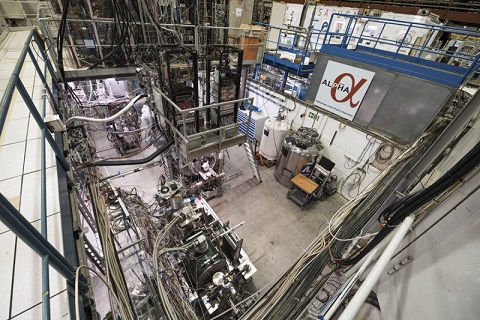|
Does the
universe contain equal amounts of matter and
antimatter?
The Big Bang should have created equal amounts
of matter and antimatter in the early
universe. But today, everything we see from the
smallest life forms on Earth to the largest
stellar objects is made almost entirely of
matter. Comparatively, there is not much
antimatter to be found. Something must have
happened to tip the balance. One of the greatest
challenges in physics is to figure out what
happened to the antimatter, or why we see an
asymmetry between matter and antimatter.
Read More.
Antimatter atom trapped and measured with a
laser for first time
Antimatter
is notoriously difficult to work with, because
the moment it touches normal matter both
annihilate in an explosion of smaller particles
and radiation. To scrutinise antimatter,
physicists have to keep it as cold as possible
and trap it using powerful magnetic fields.
Jeffrey Hangst and his colleagues in the ALPHA
collaboration, based at
CERN near Geneva, Switzerland, managed to trap
14 antihydrogen atoms at once - a dramatic
improvement over the one or two atoms of
previous experiments. To peek at the spectrum,
they shone an intense laser on to the
antihydrogen atoms, so that the beam's energy
could be absorbed and re-emitted.
The team found that the lowest-energy photons in
the antihydrogen spectrum had the same
wavelength as for hydrogen.
Because no one has persuaded an atom of
antimatter to interact with a laser before, the
measurement is still vastly less precise than
our best observations for hydrogen.
Improving the accuracy might flag up any
possible discrepancies in energy levels between
the two, which would undermine the standard
model of physics.
Read More.

Searching for antihydrogen,
CERN
What is
wrong in formal concept of antimatter?
If we want to resolve the matter - antimatter
problem radically, we need to review the Dirac's
Equation and Sea carefully by a new approach on
the antimatter concept.
The root of the problem can be attributed to the
left side of the E=mc2
relation. This means that this property
is attributed to sub-particle rather than
quantum of energy, too and the problem is
generally discussed up to finding its solution.
The
Dirac's
Equation is usually limited to the high energy
photons and the pair production and decay of a
particle - antiparticle, while Dirac's Sea can
be used for all quanta of energies.
In relativistic quantum mechanics, the problem
is that Dirac equations cannot explain virtual
pair production and decay in a vacuum.
That's why uncertainty principle is used to
justify the virtual pair production and decay in
vacuum. Richard Feynman propounded the behavior
of elementary particles calculation in series
diagrams that is called
Feynman diagrams that includes also
virtual pair production and decay of the vacuum.
Therefore, in CPH theory, defining the structure
of photon by means of Dirac equation is in fact
a physical reality that not only it satisfies
about
positrons but also it is an inseparable part of
the nature and even we can say that weyl-fermions
with spin 1/2 are massless unlike electrons and
possess a high degree of mobility; In addition,
the spin (rotation) of particle is accomplished
either in its side or
against its side that can be concluded from it.
(It comes back to definition of CPH theory).
With the
generalization the Dirac's Equation and Sea, the
similarity between
QCD and photon can be
resulted. In other words, there are color
properties not only of in quarks, but the
existences of their properties are acceptable in
photon structure and even in a
gravitational
field, too.
Other
relative articles:
What is
the universe made of? How did it start?
A
Theory of Everything
and before the Big Bang
The concept of a point-like
particle is wrong
The formal
understanding of antimatter is wrong
Does EVERYTHING happen at the same time, really?
What is light charged Higgs boson scenario,
really?

Contains: names, biographies and lectures
|


